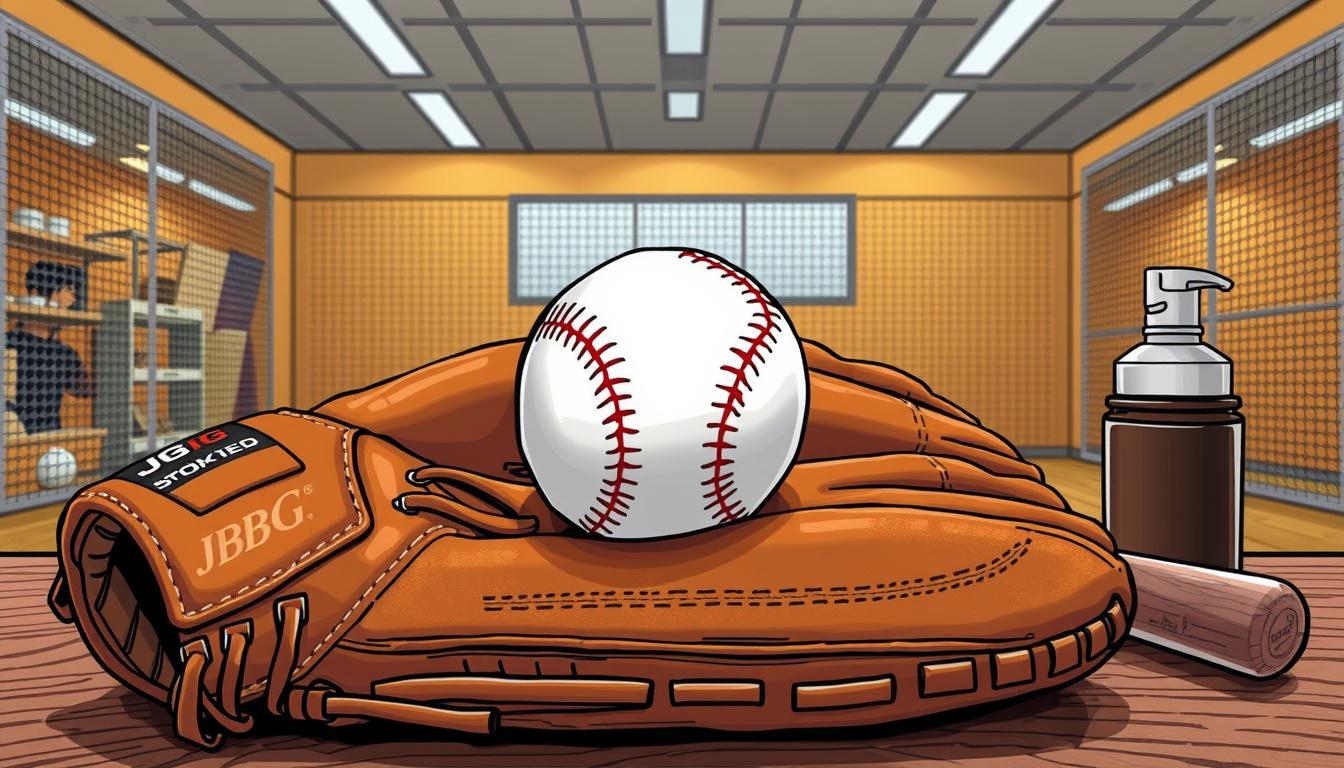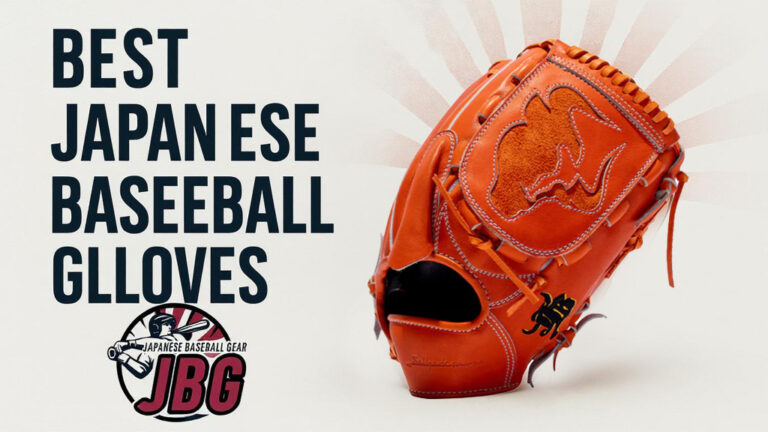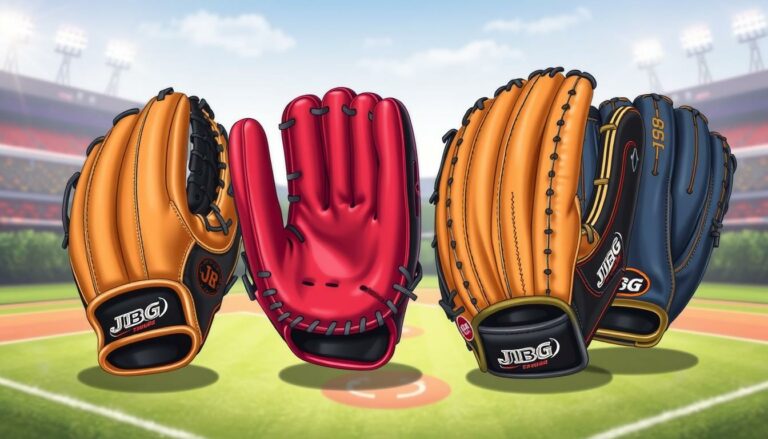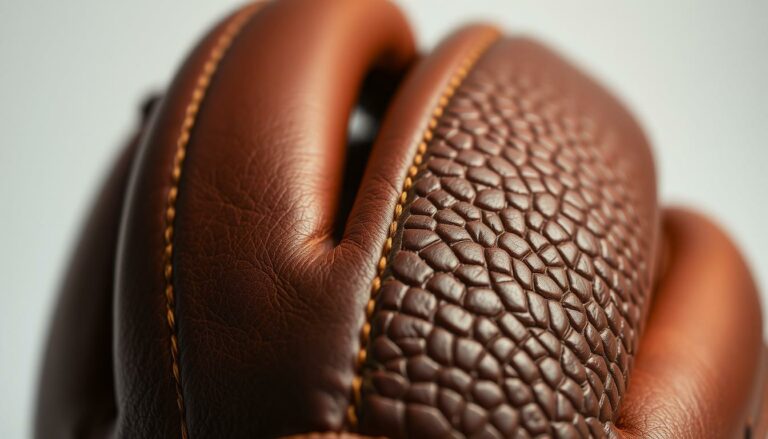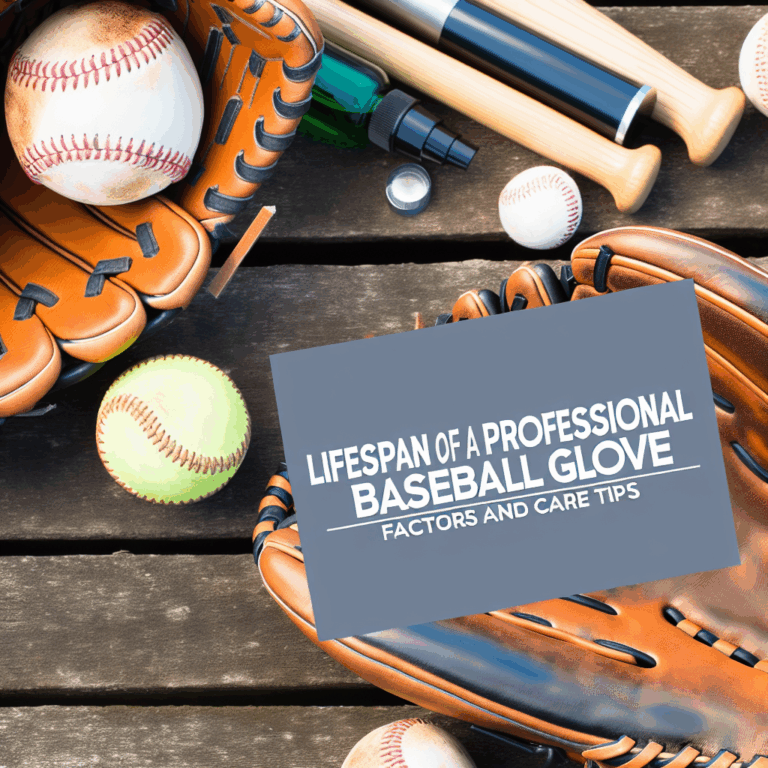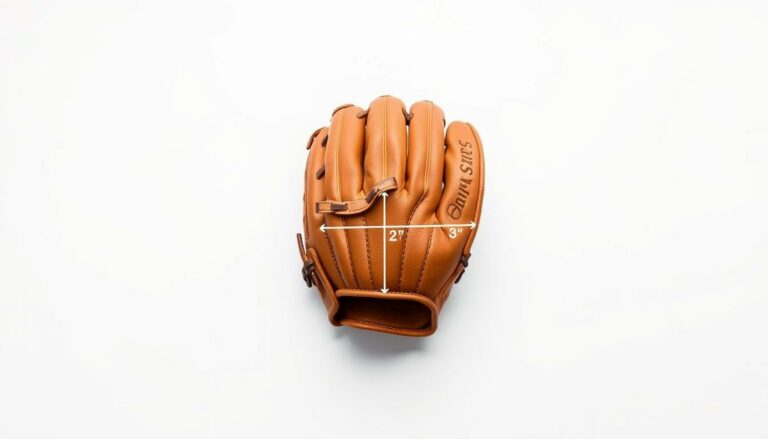How to Break In a Pro Baseball Glove Like MLB Players
Ever wondered why MLB players’ gloves fit so perfectly? The secret is in breaking in a professional baseball glove. Our company combines Japanese craftsmanship with MLB techniques to help you get that perfect fit.
Breaking in a pro baseball mitt is key for performance. A well-broken-in glove can save the game. The process takes weeks to months, depending on the leather and how often you use it1.
Want to turn your stiff glove into a fielding dream? Let’s explore how to make premium leather your fielder’s best friend.
Key Takeaways
- Pro-level break-in requires time and dedication
- Glove materials impact the break-in process
- Position-specific techniques enhance performance
- MLB players use unique methods for faster results
- Proper care extends glove life and maintains shape
- Balance between break-in speed and leather integrity is key
Understanding Pro Baseball Glove Materials and Construction
Pro baseball gloves are amazing pieces of work, made to help players do their best. Getting these gloves ready for play is key. Let’s look at what makes these top-notch gloves special.
Premium Leather Types Used in MLB Gloves
Top MLB players choose high-quality leather gloves for their edge. These gloves cost between $300 to $400 and need time to break in, sometimes weeks2. Kip leather is used in Pro Preferred gloves, while Heart of the Hide models use ultra-premium steerhide3. It’s important to care for the leather to keep the glove in good shape.
Anatomy of a Professional Baseball Glove
Professional gloves have special parts that need attention when breaking them in. The web design is key, with Pro-I being the favorite for infielders and Trap-Eze for outfielders3. Pitchers often choose closed-web designs with deep pockets for better grip3.
Position-Specific Glove Designs
Different positions need special glove designs. Infielder gloves are usually 11.25 to 11.75 inches, with the 200 model being the top choice3. Outfielders prefer larger gloves with deeper pockets, often the 300 pattern3. The Custom Glove Builder offers break-in options from 10% to 65%, affecting how soft the glove is3.
| Position | Glove Size | Popular Model | Key Features |
|---|---|---|---|
| Infielder | 11.25″ – 11.75″ | 200 | Balanced, circular shape |
| Outfielder | 12″ – 13″ | 300 | Larger size, deeper pocket |
| Pitcher | 11.5″ – 12″ | Varies | Closed-web, deep pocket |
How to Break In Professional Baseball Glove: The MLB Method
Breaking in a professional baseball glove needs patience and care. MLB players use special techniques to soften their gloves and keep them in top shape. Let’s look at the best methods used by the pros.
Playing Catch Technique
Playing catch is a natural way to break in your glove. Many players find that regular practice is the best way to soften their gloves4. This method lets the leather mold to your hand, making a perfect fit over time.
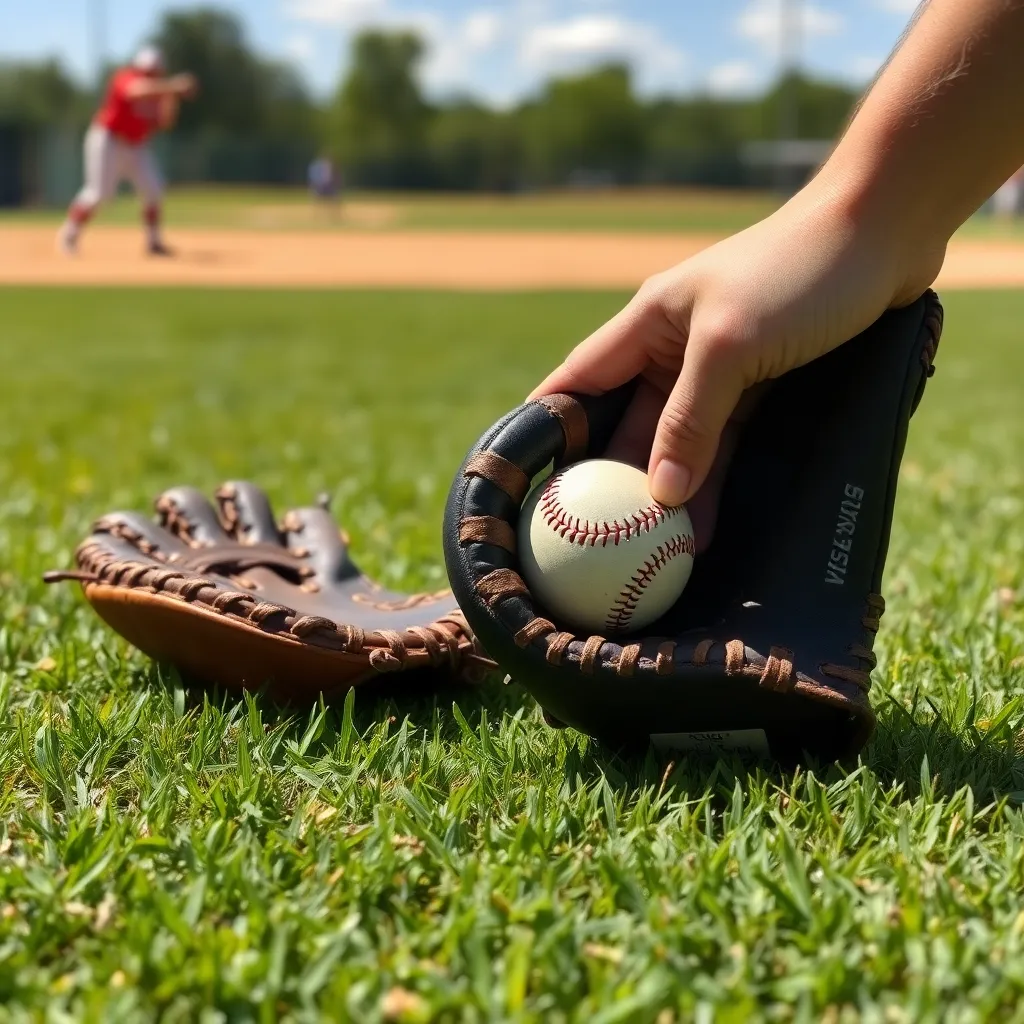
Pocket Formation Process
Creating the right pocket is key for good performance. Use a glove mallet to pound the pocket and soften the leather4. Wrap the glove with a baseball inside after each use to keep the pocket right4. Remember, high-quality leather gloves like Heart of the Hide may take longer to break in because of their tight grain5.
Professional Conditioning Methods
Keeping your pro glove in top shape includes using leather conditioners. Use products recommended by the manufacturer, avoiding harmful substances like Vaseline or olive oil4. Apply a light conditioner once a season for the best care5.
| Method | Frequency | Pros | Cons |
|---|---|---|---|
| Playing Catch | Regular | Natural break-in | Time-consuming |
| Glove Mallet | As needed | Targeted softening | Requires proper technique |
| Conditioning | Once per season | Preserves leather | Product-specific |
Some players try using microwaves to soften their gloves, but this is not recommended. It can harm the glove and void the warranty4. Stick to MLB-approved methods for the best results and to keep your glove in top condition.
Essential Tools and Products for Proper Break-In
Breaking in a baseball glove is an art that needs the right tools and techniques. Players spend a lot of time and effort to get their mitts ready for the game. Let’s look at the key equipment and products that can help you master the break-in process.
MLB-Approved Glove Conditioners
Glove conditioners are vital for softening and protecting the leather. Use a dime-sized amount of conditioner on your glove, focusing on the break points. This includes where the pinky and thumb meet the palm6.
In drier climates, keep applying conditioner even after the glove is broken in6. Aim for three to four treatments per season to keep your glove soft7.

Break-In Equipment and Tools
A wooden mallet is a common tool for shaping the pocket and softening the leather. Pound the glove pocket about 30 times with a mallet or a 5-pound neoprene dumbbell7. For tough spots, bend the glove six to eight times7.
Some players use hot water (150-170°F) to speed up the softening process. But this method isn’t officially recommended67.
Protective Storage Solutions
Storing your glove properly is essential to keep it in shape and extend its life. Place a ball in the pocket and secure it with a strap when not in use8. This prevents creasing and keeps the glove ready for the game.
With the right care, your glove can last for years. One player used the same glove for 13 years8!
| Break-In Method | Frequency | Duration |
|---|---|---|
| Playing Catch | Daily | 3 weeks – few months |
| Applying Conditioner | 3-4 times per season | 24 hours absorption |
| Mallet Pounding | 30 times per session | Multiple sessions |
| Rubber Band Shaping | As needed | 4-5 hours |
Remember, the best baseball mitt break-in tips involve consistent play and proper care. While tools can help, nothing beats regular use on the field. This creates a glove that feels like a natural part of your hand8.
MLB Player Break-In Secrets and Techniques
MLB players use many ways to make their gloves fit just right. Some try heating their gloves in the microwave for 30 seconds or in an oven at 300°F for 2-3 minutes9. This method softens the leather fast, but be careful not to harm the glove.
Many players stick to traditional ways of oiling their gloves. Ken Griffey Jr. had his gloves prepared by his dad, while others use a mallet to shape the pocket910. Nomar Garciaparra, for example, used the same glove for years, showing how important the right fit is10.
Interestingly, many players use 2 gloves a season, while Jack Wilson might use one for 6 seasons9. Some use rubber bands or shaving cream to break in their gloves10. For those who want help, places like Katz Sport Shop offer glove conditioning services10.
The secret to a well-broken-in glove is using it a lot and taking good care of it. Whether you heat it up, oil it, or just play catch, being patient and consistent is key. By mixing these MLB tips with what you like, you’ll get a glove that feels like a part of you.
FAQ
Q: How long does it typically take to break in a professional baseball glove?
Q: What type of leather is best for a quick break-in?
Q: Is it safe to use heat methods like microwaving to break in a glove?
Q: How often should I condition my baseball glove during the break-in process?
Q: Can I use household oils like olive oil or vaseline to condition my glove?
Q: How do I know if I’m breaking in my glove correctly for my position?
Q: Is it better to break in a glove manually or use break-in tools?
Q: How can I prevent my glove from becoming too soft during break-in?
Q: What’s the best way to store my glove between uses during the break-in period?
Q: Can professional break-in services damage my glove?
Source Links
- How to Break in a Baseball Glove | Do’s and Don’ts of the Break In Process – https://www.whatproswear.com/baseball/news/the-fine-art-or-exact-science-of-breaking-in-a-new-baseball-glove-dos-and-donts-of-the-break-in-process/
- How to Break in a Baseball Glove (The Right Way) – – https://thehittingvault.com/how-to-break-in-a-baseball-glove/
- What to Consider When Building a Custom Glove | Rawlings – https://www.rawlings.com/what-to-consider-when-building-custom-glove.html
- How to Break in a Baseball Glove: Step-by-Step Guide – https://www.baseballmonkey.com/learn/how-to-break-in-a-baseball-glove
- How to Break In Your Glove the Rawlings Way – https://www.rawlings.com/how-to-break-in-your-glove.html
- How To Break In A Glove The Right Way | JustBallGloves | JustGloves.com – https://www.justballgloves.com/glove-resource-guide/breaking-in-a-glove/?srsltid=AfmBOoq6ciKZTwnthLP7YCLtsAu9qcDRJwQCj0lEVUwWEtR4_EOutjNj
- How to Break in a Baseball Glove – https://www.dickssportinggoods.com/protips/sports-and-activities/softball/how-to-break-in-a-baseball-glove?srsltid=AfmBOopUrhuimGG_siG-he9UE2OQKveg_ZiqLtiGwACTwi4gOqasy1f6
- How to Break In a Baseball Glove – https://www.nike.com/a/how-to-break-in-baseball-glove
- Caple: How to break in a new baseball glove – https://www.espn.com/mlb/columns/story?columnist=caple_jim&id=5173365
- The Fine Art of Breaking in a Glove | MOJO Sports – https://mojo.sport/coachs-corner/the-fine-art-of-breaking-in-a-glove/

